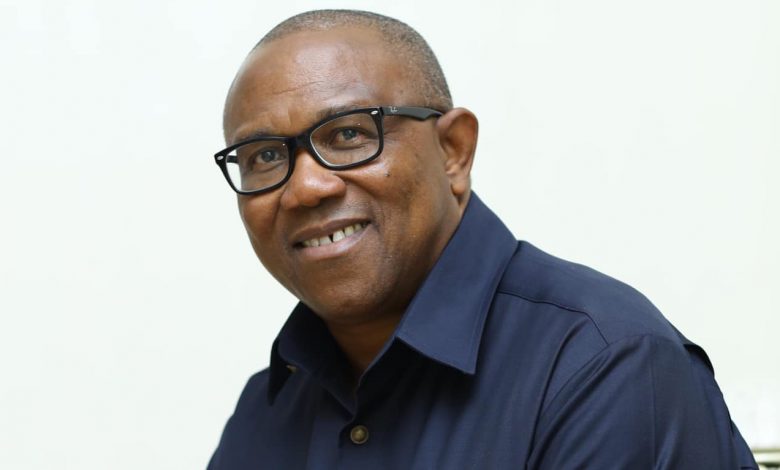Headline
Opinion:COVID-19: The Pandemic That Changed Everything-Charles Otudor
Published
4 years agoon
By
Editor
Related
You may like
Headline
Lagos-Calabar Coastal Highway: Prioritize Existing Unfinished Projects, Peter Obi Tells FG
Published
2 days agoon
April 22, 2024By
Eric
Mr. Peter Obi, the Labour Party’s presidential candidate in the 2023 general election, has advised the federal government to prioritize existing unfinished projects spread across the country instead of the Lagos-Calabar coastal highway project.
Obi, in a series of posts on X (formerly Twitter) on Monday, stated that the project was a misplaced priority given the numerous unfinished roads throughout the country.
The former governor of Anambra State mentioned that the budget allocated to the Ministry of Works is insufficient for significant progress on the country’s various unfinished roads, much less their completion.
Obi therefore, advised that the government prioritize the existing infrastructural projects in the country before embarking on any new and colossal projects like the Lagos-Calabar super highway project.
“The Federal Ministry of Works 2024 capital budget of N892,461,262,656.00, additional funding from multilateral loan projects of N94,828,535,243.00, alongside other expected contributions from sources like the China-Exim Bank and the World Bank, will not be enough for serious work on all the critical roads, some of which I enumerated above, let alone their completion.
So, why embark on another huge project that will not be completed in the next 20 or 30 years?
“To do so will only exacerbate the problem of abandoned, uncompleted projects that are not contributing to economic growth and overall development.
“Therefore, while acknowledging the potential benefits of coastal superhighway infrastructure, I urge prioritization of our existing uncompleted projects. We must allocate resources towards repairing and completing existing infrastructure.
“In any development formula, the primary focus should be on completing and rehabilitating existing infrastructure rather than embarking on colossal new projects that may never reach completion within the next 30 years,” Obi said.
Back in March, the Federal Government began constructing the 700-kilometer Lagos-Calabar Coastal Highway, designed to extend through 9 states with two spurs leading to the Northern States.
Recall that former Vice President, Atiku Abubakar, had earlier described the project as a fraud.
“Umahi had announced that Hitech would fully fund the project, and based on this, there was no competitive bidding. He (Umahi) then said that Hitech could only raise just 6% of the money for the pilot phase. This smacks of deceit,” Atiku said.
Related
Headline
2027 Presidential Race: Opposition Parties Under Attack
Published
3 days agoon
April 21, 2024By
Eric
By Eric Elezuo
While it is still a whole three years before the next general election in 2027, The Boss has learnt that opposition parties in the countries are being muffled to pave the way for the ruling All Progressives Congress (APC) to return to, and retain power.
From the Peoples Democratic Party (PDP), to the Labour Party (LP), and down to the New Nigerian Peoples Paty (NNPP), crises have engulfed the rank and files, in what a source told this paper was the attempt and making of the ruling party, APC, to decimate, destabilize and make redundant the machineries of the opposition parties.
It is believed that by 2027, the apparatuses holding together the various opposition parties would have weakened irredeemably to the extent the country would seemingly nosedive into the inglorious one party state that every civil right advocate and democrats abhor.
It is alleged that all the crises in all the opposition parties are being engineered by the President Bola Tinubu-led ruling APC, with the hope of getting the fibres of their system weakened, thereby luring the members of the crisis-ridden parties into the APC.
Slightly one year after the last presidential election, the two major opposition platforms, Peoples Democratic Party (PDP) and the Labour Party, have separately been embroiled in a crisis of confidence which has diminished their capacity to provide viable opposition to the ruling All Progressives Congress (APC).
The crises in both opposition parties got to a head. The Labour Party led by its national chairman Julius Abure held its much-opposed national convention which was boycotted by its 2023 presidential candidate, Peter Obi; its only governor, Alex Otti of Abia State; federal and state lawmakers elected on its platform, and the organised Labour.
In the Labour Labour, members have been embroiled in endless battle of supremacy with a faction led by Mr. Apapa steadily contesting the leadership of Julius Abure.
Consequently, the presidential candidate of the party in the 2023 elections, Mr. Peter Obi, reverence as a leader in the fold, noting that whatever the party faces presently, that Nigeria’s problems are far bigger than the crises in his party.
The LP has been embroiled in crises — ranging from allegations of misappropriation of funds, and leadership tussle, to calls for the resignation of the party’s national chairman.
TheCable reported that “On March 27, the LP conducted a national convention in Anambra state where Julius Abure was re-elected as its national chairman.
Obi did not attend the convention, fuelling speculations that he may be mulling over ditching the LP for another platform.
Speaking during an appearance on HaveYourSay247, an interactive online session hosted by Rudolf Okonkwo over the weekend, Obi said he is confident that the crises rocking the LP will soon be resolved amicably.
“Whatever is happening in the Labour Party is so minute compared to what is happening in the country,” Obi said.
“So, for me, it is something we will resolve amicably, and it is not anything to worry about. Let us worry about the country.
“Let us worry about how the average Nigerian would be able to have a means of livelihood to be able to eat, that should be our worry.”
Obi said he has no interest in being the party’s leader but only to make sure things are done properly.
“I don’t see what I do in politics as being the leader of any place or not. My position is that just like I always say, I am not desperate to be president of Nigeria, I am desperate to see Nigeria work because I know it can work,” he added.
“We have a more desperate situation. Parties are just a means to be able to contest elections. What is important is that being a leader of a party does not reduce the price of food.
In the PDP, the shenanigans of former Rivers State Governor, Mr. Nyesom Wike, has practically kept the party in constant crisis with many observers concluding that the now Minister of the Federal Capital Territory (FCT) is working for the APC, and is just a mole in the PDP. Wike has denied the allegation, however,
But news filtered in last week as that the immediate past Governor of Rivers State, and Minister may have concluded plans to attend the much advertised National Executive Council (NEC) meeting of the main opposition party, the Peoples Democratic Party (PDP), billed to hold on Thursday, in Abuja.
Impeccable source, who is in the know, told The Boss that the minister, whose membership of the PDP is yet to be revoked even as he frolicks with the ruling All Progressives Congress (APC), and serving in the President Bola Tinubu government as a minister.
The Source told The Boss that Wike’s impending presence at the NEC meeting on Thursday was not unconnected with plans, already hatched with some governors, to weaken the opposition PDP.
“Yes, we have on good authority that FCT minister, Wike is planning to attend the NEC meeting tomorrow all in a bid to weaken the fabrics of the PDP, and pave the way for the continuation of the Tinubu administration come 2027, and by extension, relapse Nigeria to a full blown one party state.
“From every indication, Wike and his co-travellers, are bent on unleashing the same crisis ravaging the third force, Labour Party, and Senator Rabiu Kwankwaso’s Nigerian National People’s Party (NNPP) on the PDP for the APC to remain the only political party in the country, and ensure that Tinubu has no challenger, come 2027,” the Source said.
It would be recalled that Wike has boasted over and again that there’s no opposition against Tinubu’s re-emergence in 2027, and that they have made sure of that. He has been compensated with the Ministerial job after he withdrew support for his party, and supported the APC and Tinubu to emerge as national government.
The Source further revealed that in the attempt to actualize the intended one party state, a lot of funding is ongoing to ensure that concerned stakeholders are ‘settled’ handsomely.
Wike, prior, during and after the 2023 general elections, has been floating in between the two major political parties; the APC and the PDP. While he claim to still be a member of the PDP, he is functioning as a minister in an APC government, mocking the inability of his party to discipline him.
While political stakeholders concluded that the outcome of the Thursday’s PDP NEC meeting will determine the path Nigeria’s political trajectory will take, and that it may portend the end of multi-party system and political democracy if Wike succeeds in his plan; every page of what finally transpired at the meeting pointed to the fact.
The much touted removal of the party chairman, who is believed to be a crony of the Abuja minister, Damagum, retained his seat, with his executives.
“It is very clear to everyone that a lot of money politics is being played to cajole many loyal members of the party, forcing them into frustration, and eventually it of the party. The option afterwards, will be the APC. This, will for all intent and purpose actualize the intended one party state as an APC agenda.
The Musa Rabiu Kwankwaso-led NNPP is not faring better either. The only governor under their ticket, Abba Kabir Yusuf, just had the confidence of their party on him withdrawn. He was fighting for his political life until suddenly it was announced the the APC in Kano has collapsed its structure into the NNPP.
“This is just another APC strategy to actualize their hidden intentions. Time will reveal the very sinister agenda they harboring,” an analyst said.
Much as 2027 is still three years away, but intrigues are in play to render Nigeria a one party state, and perpetuate the APC in power. The three other opposition parties are basically under attack to bring to pass this unpopular agenda.
Related
Headline
Akwa Ibom Government, Governor Umo Eno Receive Top Honors at the 10th Wonders of the World Expo in Lagos
Published
3 days agoon
April 21, 2024By
Admin
The Akwa Ibom State Government and Governor Pastor Umo Eno were recognized with Travellers Awards at the 10th Wonders of the World Expo in Lagos for their sustained enhancement of infrastructure, support for local talent, and dedication to investment in the tourism sector. The ceremony took place at the National Museum in Onikan, Lagos.
While Akwa Ibom won the Most Active Tourism State of the Year, Governor Eno was adjudged the most Tourism-Friendly Governor of the Year at the event that had Minister of Tourism, Mrs. Lola Ade John in attendance.
According to Amb. Ikechi Uko, Founder/Publisher of ATQ Magazine, the organizers of the event which is in its tenth edition, Akwa Ibom State won the top prize “in recognition of its valiant and resourceful efforts to drive and sustain domestic tourism by promoting the industry.

‘In 2023, Akwa Ibom was one of the states that hosted World Tourism Day (WTD ) events. The state also organized the famous Christmas Unplugged, which featured music, food, and cultures from all 31 LGAs as well as ensured friendly policies.”
While hoping that the Travellers Awards would spur Akwa Ibom to do more to dominate the domestic tourism industry, the organizers hoped that the state would gradually evolve into one of Nigeria’s top international tourism destinations.
That was not all, the state Commissioner of Culture and Tourism, Sir Charles Udoh was also recognized as one of the Top 100 Tourism Personalities in Nigeria for demonstrating exceptional leadership and innovation in the travel and tourism industry, while other Akwa Ibom indigenes and entity were also celebrated: Mrs. Ime Udo, Honorary Special Adviser to the Governor( Tourism) won Tourism Promoter of the Year, Favour Udo won Tourism Photographer of the Year, Loretta Effiong and Prince Uduak Sunday (Qua Tours) were listed among the Tourism Personalities of the Year and Ibom Air won Airline of the Year International.

In his remarks, Sir Charles Udoh, who represented the Governor at the event, thanked the organizers for the awards and noted that Akwa Ibom is certainly enjoying the golden era when it comes to tourism development. He stated that Governor Umo Eno is very keen on making Akwa Ibom a leading tourism destination with his programmes and policies.
He revealed that with the new Victor Attah International Airport nearing completion, the purchase of a ferry for the Oron-Calabar route, new developments along its coastline and the restoration work that will be done at all its major tourism sites, Akwa Ibom is well on the way to becoming the number one destination for all domestic and foreign tourists.
In her speech, Tourism Minister, Mrs. Ade John hailed the organizers for hosting the Expo, where practitioners were lectured by top experts while also rewarding those who have excelled in the past year.

She affirmed that her ministry is open to partnership with public and private sector operators, adding that tourism development can only be successful through collaborative efforts.
The event, which attracted leading and budding tourism professionals, also featured interactive and entertainment sessions.
Apart from Sir Charles Udoh and Mrs. Ime Udo, the Akwa Ibom State delegation, also included: Mr. Michael Effiong James, Senior Special Assistant (Lagos Liaison) to Governor, Mrs. Eme Bassey, Special Assistant to Governor (Lagos Liaison) and Akparawa John Offiong, Deputy Director ( Culture) Ministry of Culture and Tourism.
More photos below:







Related


I’ll Resign If Yaya Bello Eacapes Prosecution, EFCC Chair Vows

Nigeria Air Scam: EFCC Arrests Former Aviation Minister, Hadi Sirika

Dana Air Confirms Runway Excursion Involving It’s Aircraft, Says Passengers, Crew Safe

Kwibuka 30: Nigerian Community In Rwanda Visits Kigali Genocide Memorial

FG Mulls Review of Admission Age into Nigerian Universities

Lagos-Calabar Coastal Highway: Prioritize Existing Unfinished Projects, Peter Obi Tells FG

FirstBank Appoints New MD/CEO, Alebiosu

Nigerian Engineer Wins $500m Contract to Build Monorail Network in Iraq

WORLD EXCLUSIVE: Will Senate President, Bukola Saraki, Join Presidential Race?

World Exclusive: How Cabal, Corruption Stalled Mambilla Hydropower Project …The Abba Kyari, Fashola and Malami Connection Plus FG May Lose $2bn

Rehabilitation Comment: Sanwo-Olu’s Support Group Replies Ambode (Video)

Pendulum: Can Atiku Abubakar Defeat Muhammadu Buhari in 2019?

Fashanu, Dolapo Awosika and Prophet Controversy: The Complete Story

Pendulum: An Evening with Two Presidential Aspirants in Abuja

Who are the early favorites to win the NFL rushing title?

Boxing continues to knock itself out with bewildering, incorrect decisions

Steph Curry finally got the contract he deserves from the Warriors

Phillies’ Aaron Altherr makes mind-boggling barehanded play

The tremendous importance of owning a perfect piece of clothing
Trending
-

 News6 years ago
News6 years agoNigerian Engineer Wins $500m Contract to Build Monorail Network in Iraq
-

 Featured6 years ago
Featured6 years agoWORLD EXCLUSIVE: Will Senate President, Bukola Saraki, Join Presidential Race?
-

 Boss Picks6 years ago
Boss Picks6 years agoWorld Exclusive: How Cabal, Corruption Stalled Mambilla Hydropower Project …The Abba Kyari, Fashola and Malami Connection Plus FG May Lose $2bn
-

 Headline6 years ago
Headline6 years agoRehabilitation Comment: Sanwo-Olu’s Support Group Replies Ambode (Video)
-

 Headline5 years ago
Headline5 years agoFashanu, Dolapo Awosika and Prophet Controversy: The Complete Story
-

 Headline6 years ago
Headline6 years agoPendulum: Can Atiku Abubakar Defeat Muhammadu Buhari in 2019?
-

 Headline6 years ago
Headline6 years agoPendulum: An Evening with Two Presidential Aspirants in Abuja
-

 Headline6 years ago
Headline6 years ago2019: Parties’ Presidential Candidates Emerge (View Full List)

